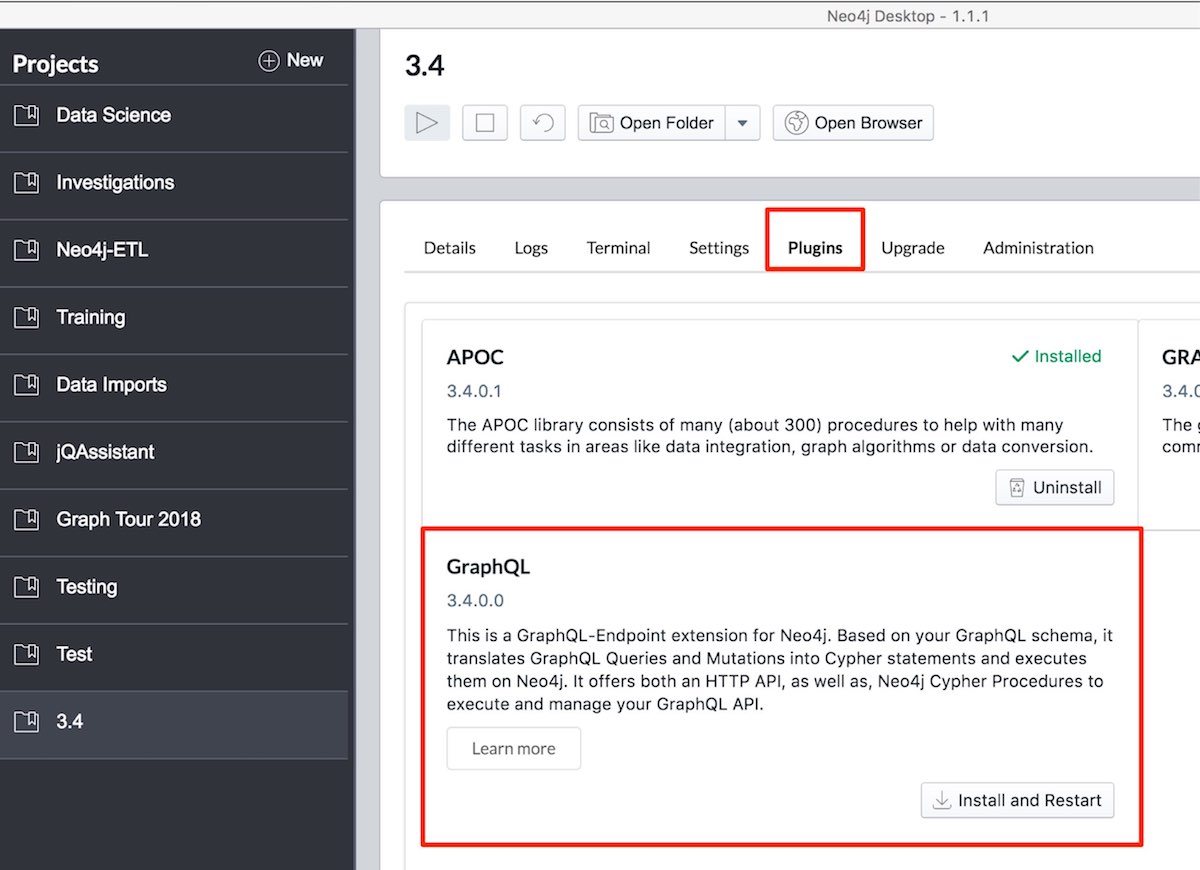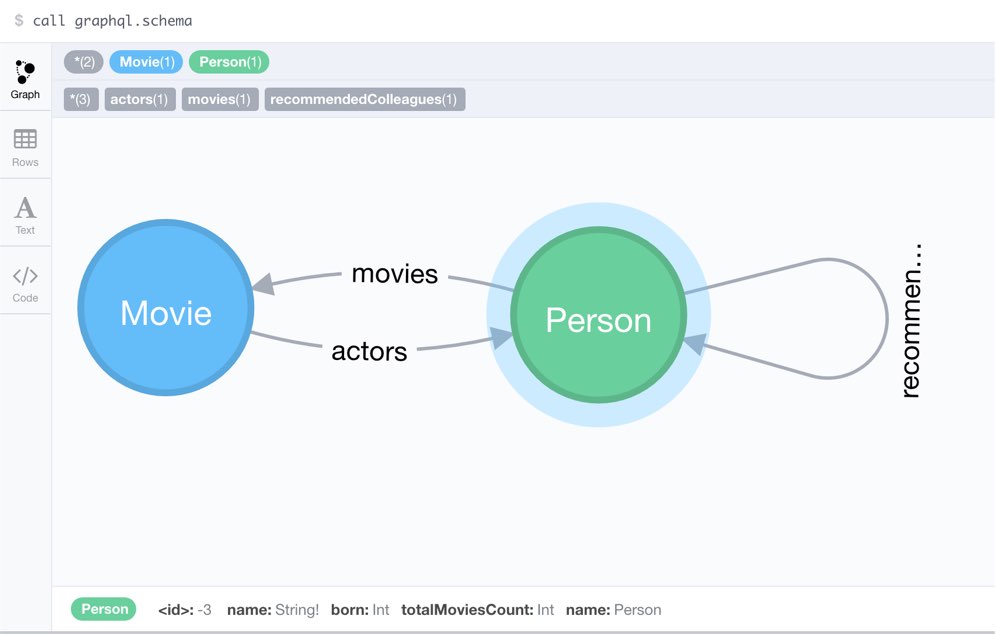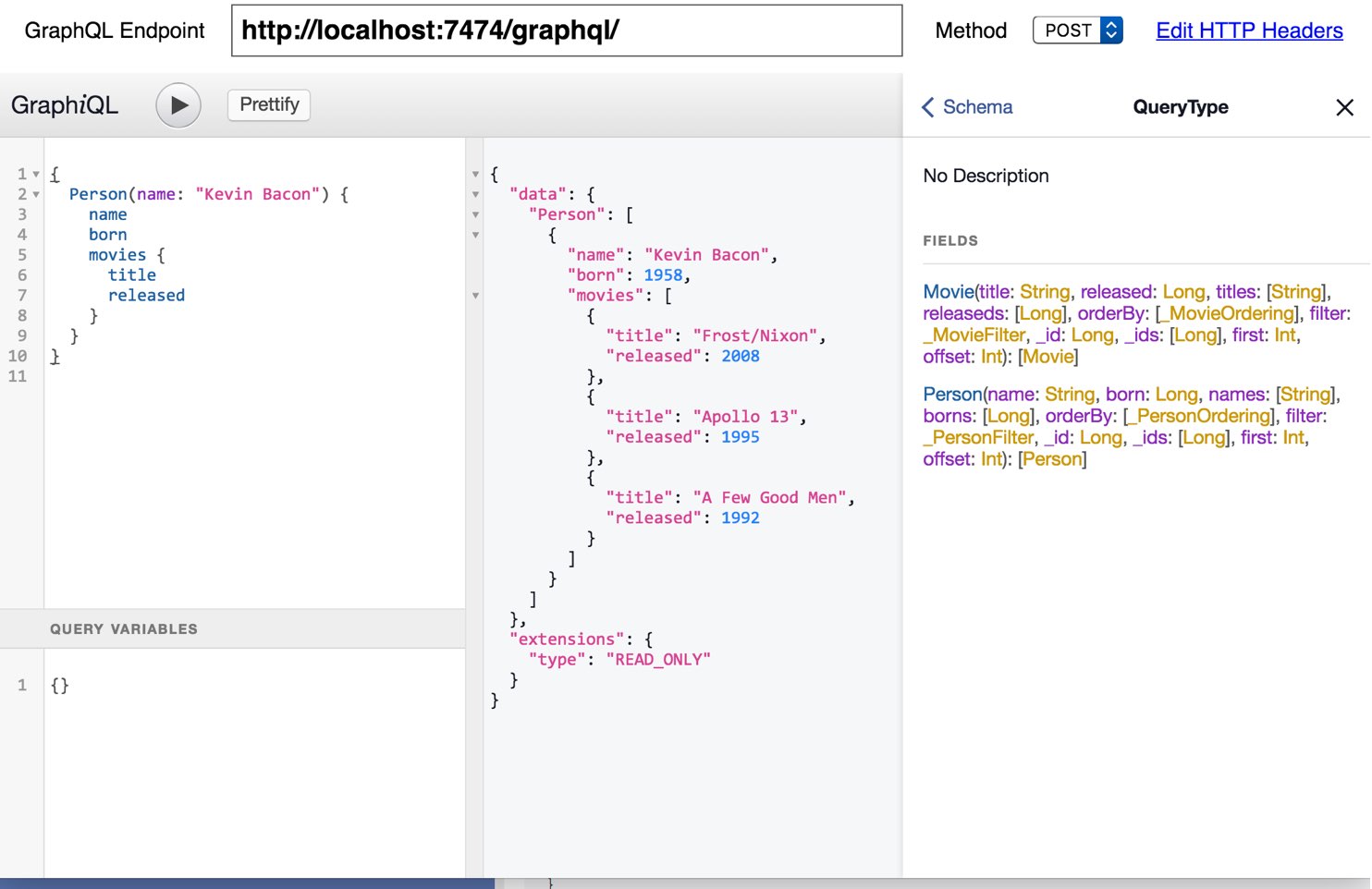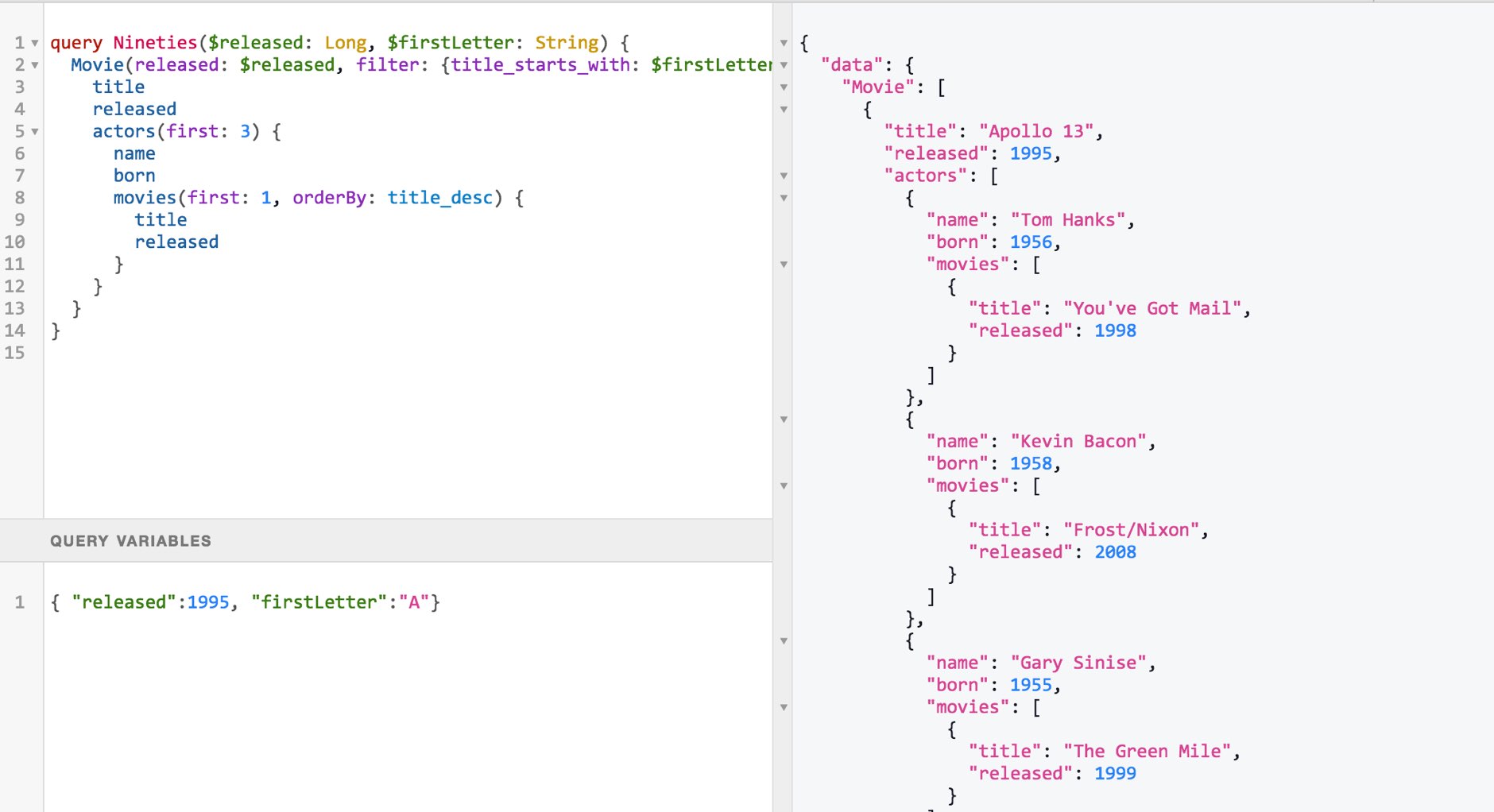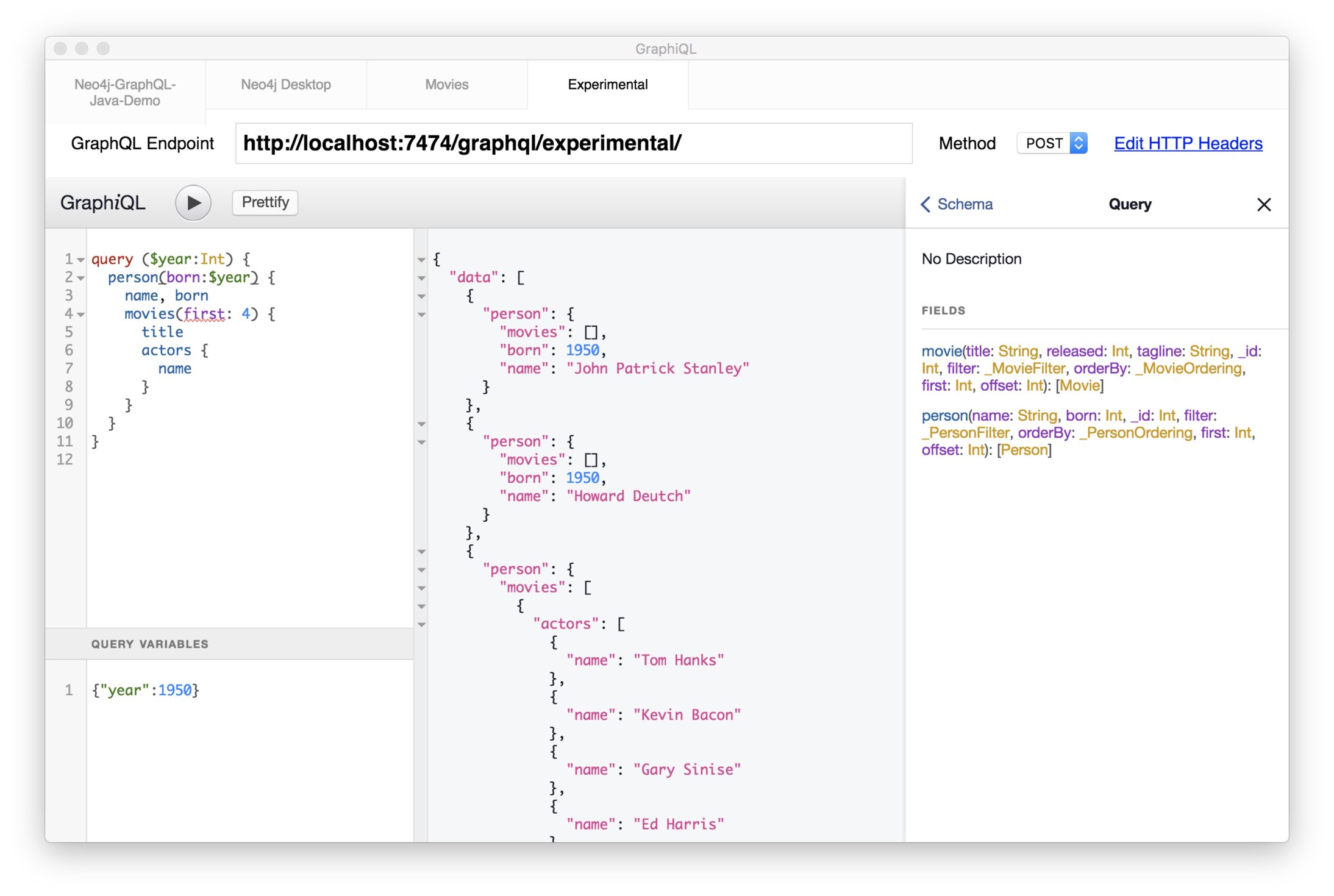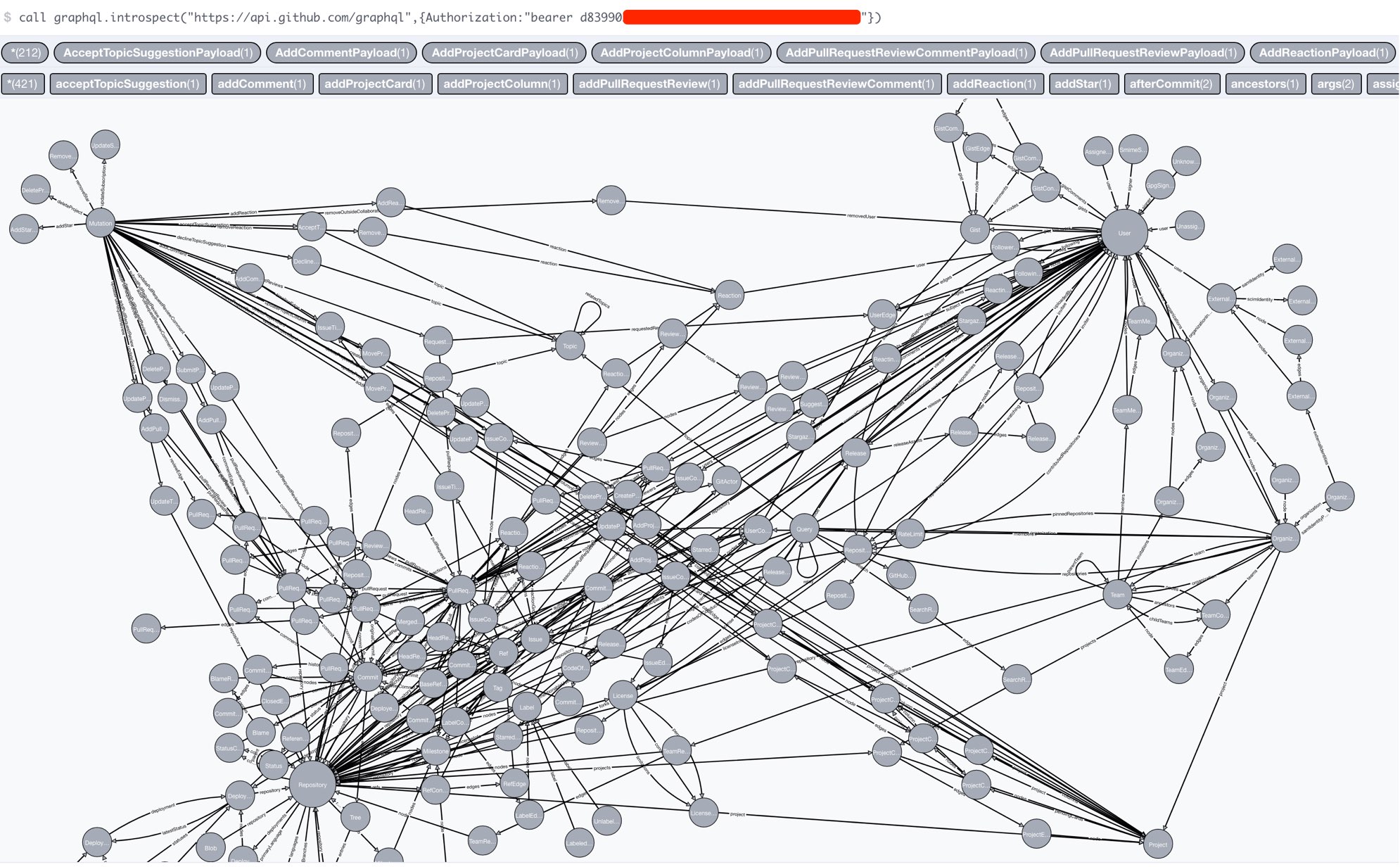|
Note
|
The plugin is considered end-of-life. It will not be updated for Neo4j 4.0, we recommend to move a middleware based solution using neo4j-graphql-js or neo4j-graphql-java. After a lot of feedback we think separating the GraphQL API from the core database is the better architectural setup. |
This is a GraphQL-Endpoint extension for Neo4j. It is part of the GRANDstack
Based on your GraphQL schema, it translates GraphQL Queries and Mutations into Cypher statements and executes them on Neo4j.
It offers both an HTTP API, as well as, Neo4j Cypher Procedures to execute and manage your GraphQL API.
Download and install Neo4j Desktop
Neo4j Desktop provides a quick install button for neo4j-graphql.
After creating your database you can find it under "Manage" in the "Plugins" tab for a single click install.
This extension is utilized, when you use neo4j-graphql-cli
This tool
-
launches a Neo4j Sandbox with your GraphQL schema
-
provides the
/graphql/endpoint, -
a Neo4j server,
-
an hosted GraphiQL for it.
npm install -g neo4j-graphql-cli neo4j-graphql movies-schema.graphql
To generate some graph data in Neo4j just run :play movie graph in your Neo4j Browser.
The best tool to use is GraphiQL the GraphQL UI. Get and install it.
Enter your GraphQL URL, like http://localhost:7474/graphql/ (note the trailing slash).
If your Neo4j Server runs with authentication enabled, add the appropriate Basic-Auth (base64 encoded) username:password header in the "Edit HTTP Headers" screen.
Authorization header value.echo "Basic $(echo -n "neo4j:<password>" | base64)"
Here is a small example schema for the movie data. Just a Movie with actors, and a Person with movies.
Simple properties are mapped directly while the relationships are mapped to fields movies and actors
type Movie {
title: String!
released: Int
actors: [Person] @relation(name:"ACTED_IN",direction:IN)
}
type Person {
name: String!
born: Int
movies: [Movie] @relation(name:"ACTED_IN")
}You can POST a GraphQL schema to the /graphql/idl/ endpoint or run the CALL graphql.idl('schema-text') procedure.
The payload is parsed and stored in Neo4j and used subsequently as the backing GraphQL schema for validating and executing queries.
CALL graphql.idl('
type Movie {
title: String!
released: Int
tagline: String
actors: [Person] @relation(name:"ACTED_IN",direction:IN)
}
type Person {
name: String!
born: Int
movies: [Movie] @relation(name:"ACTED_IN")
}
')You should then be able to see your schema in the Docs section of GraphiQL.
This also gives you auto-completion, validation and hints when writing queries.
With graphql.reset() you can trigger the reset of you schema.
But it also updates automatically if changed on other cluster members.
Latest after 10 seconds.
To visualize your GraphQL schema in Neo4j Browser use: call graphql.schema().
Using
RETURN graphql.getIdl()
you’ll get back a string representation of the currently used schema.
From that schema, the plugin automatically generate Query Types for each of the declared types.
e.g. Movie(title,released,first,offset,_id,orderBy, filter): [User]
-
Each field of the entity is available as query argument, with an equality check (plural for list-contains)
-
We also provide a
filterargument for more complex filtering with nested predicates, also for relation-fields (see graphcool docs) -
For ordered results there is a
orderByargument -
And
first,offsetallow for pagination
Now you can for instance run this query:
{ Person(name:"Kevin Bacon") {
name
born
movies {
title
released
tagline
}
}
}query Nineties($released: Int, $letter: String)
{ Movie(released: $released,
filter: {title_starts_with: $letter,
actors_some: { name_contains: $letter}}) {
title
released
actors(first: 3) {
name
born
movies(first: 1, orderBy: title_desc) {
title
released
}
}
}
}
# query variables
{ "released":1995, "letter":"A"}This query declares query name and parameters (first line), which are passed separately ("Query Parameters box") as JSON.
And get this result:
Additionally Mutations for each type are created, which return update statistics.
e.g. for the Movie type:
-
createMovie(title: ID!, released: Int) : String -
mergeMovie(title: ID!, released: Int) : String -
updateMovie(title: ID!, released: Int) : String -
deleteMovie(title: ID!) : String
and for it’s relationships:
-
addMovieActors(title: ID!, actors:[ID]!) : String -
deleteMovieActors(title: ID!, actors:[ID]!) : String
Those mutations then allow you to create and update your data with GraphQL.
mutation {
createPerson(name:"Chadwick Boseman", born: 1977)
}{ "data": {
"createPerson": "Nodes created: 1\nProperties set: 2\nLabels added: 1\n"
}
}mutation {
pp: createMovie(title:"Black Panther", released: 2018)
lw: createPerson(name:"Letitia Wright", born: 1993)
cast: addMovieActors(title: "Black Panther",
actors:["Chadwick Boseman","Letitia Wright"])
}If multiple mutations are sent as part of the same request, they will be executed in the same transaction (meaning if one of them fails they will all fail). If the same mutation is called multiple times, you need to use alias prefixes to avoid clashes in the returned data, which is keyed on mutation names.
You can use those mutations also to load data from CSV or JSON.
Directives like @directiveName(param:value) can be used to augment the schema with additional meta-information that we use for processing.
You have already seen the @relation(name:"ACTED_IN", direction:"IN") directive to map entity references to graph relationships.
The @cypher directive is a powerful way of declaring computed fields, query types and mutations with a Cypher statement.
directorstype Movie {
...
directors: [Person] @cypher(statement:"MATCH (this)<-[:DIRECTED]-(d) RETURN d")
}schema {
query: QueryType
mutation: MutationType
}type QueryType {
...
coActors(name:ID!): [Person] @cypher(statement:"MATCH (p:Person {name:$name})-[:ACTED_IN]->()<-[:ACTED_IN]-(co) RETURN distinct co")
}type MutationType {
...
rateMovie(user:ID!, movie:ID!, rating:Int!): Int
@cypher(statement:"MATCH (p:Person {name:$user}),(m:Movie {title:$movie}) MERGE (p)-[r:RATED]->(m) SET r.rating=$rating RETURN r.rating")
}type Movie {
title: String!
released: Int
actors: [Person] @relation(name:"ACTED_IN",direction:IN)
directors: [Person] @cypher(statement:"MATCH (this)<-[:DIRECTED]-(d) RETURN d")
}
type Person {
name: String!
born: Int
movies: [Movie] @relation(name:"ACTED_IN")
}
schema {
query: QueryType
mutation: MutationType
}
type QueryType {
coActors(name:ID!): [Person] @cypher(statement:"MATCH (p:Person {name:$name})-[:ACTED_IN]->()<-[:ACTED_IN]-(co) RETURN distinct co")
}
type MutationType {
rateMovie(user:ID!, movie:ID!, rating:Int!): Int
@cypher(statement:"MATCH (p:Person {name:$user}),(m:Movie {title:$movie}) MERGE (p)-[r:RATED]->(m) SET r.rating=$rating RETURN r.rating")
}Currently we’re working on a independent transpiler (neo4j-graphql-java) of GraphQL to Cypher which can also be used for your own GraphQL servers or middleware on the JVM.
This takes a given GraphQL schema, augments it and then uses that schema to generate Cypher queries from incoming GraphQL queries.
There are small examples of writing GraphQL servers in the repository, but we also wanted to make the new implementation available for testing.
That’s why we integrated the new transpiler at the URL: http://localhost:7474/graphql/experimental/ in this plugin, so that you can test it out. It uses the schema of the main implementation.
Currently supported features are:
-
parse SDL schema
-
resolve query fields via result types
-
handle arguments as equality comparisons for top level and nested fields
-
handle relationships via @relation directive on schema fields
-
@relation directive on types for rich relationships (from, to fields for start & end node)
-
filter for top-level query-fields
-
handle first, offset arguments
-
argument types: string, int, float, array
-
request parameter support
-
parametrization for cypher query
-
aliases
-
inline and named fragments
-
auto-generate query fields for all objects
-
@cypher directive for fields to compute field values, support arguments
-
auto-generate mutation fields for all objects to create, update, delete
-
@cypher directive for top level queries and mutations, supports arguments
For more details see the readme of the transpiler repository.
Here is a query example against the movie graph:
{
person(born:1950) {
name, born
movies(first: 4) {
title
actors {
name
}
}
}
}This library also comes with Cypher Procedures to execute GraphQL from within Neo4j.
CALL graphql.query('{ Person(born: 1961) { name, born } }')WITH 'query ($year:Long,$limit:Int) { Movie(released: $year, first:$limit) { title, actors {name} } }' as query
CALL graphql.query(query,{year:1995,limit:5}) YIELD result
UNWIND result.Movie as movie
RETURN movie.title, [a IN movie.actors | a.name] as actorsCALL graphql.execute('mutation { createMovie(title:"The Shape of Water", released:2018)}')Please leave Feedback and Issues
You can get quick answers on Neo4j-Users Slack in the #neo4j-graphql channel
License: Apache License v2.
This branch for Neo4j 3.5.x
| name | information | example |
|---|---|---|
entities |
each node label represented as entity |
|
multi entities |
multiple entities per query turned into |
|
property fields |
via sampling property names and types are determined |
|
field parameters |
all properties can be used as filtering (exact/list) input parameters, will be turned into Cypher parameters |
|
query parameters |
passed through as Cypher parameters |
|
filter arguments |
nested input types for arbitrary filtering on query types and fields |
|
filter arguments for relations |
filtering on relation fields, suffixes ("",not,some, none, single, every) |
|
relationships |
via a |
|
ordering |
via an extra |
|
pagination |
via |
|
schema first IDL support |
define schema via IDL |
|
Mutations |
create/delete mutations inferred from the schema |
|
Cypher queries |
|
|
Cypher updates |
Custom mutations by executing |
|
extensions |
extra information returned |
|
|
Note
|
@cypher directives can have a passThrough:true argument, that gives sole responsibility for the nested query result for this field to your Cypher query.
You will have to provide all data/structure required by client queries.
Otherwise, we assume if you return object-types that you will return the appropriate nodes from your statement.
|
The extension works with Neo4j 3.x, the code on this branch is for 3.5.
Please consult the Neo4j documentation for file locations for the other editions on the different operating systems.
-
Download the appropriate neo4j-graphql release for your version.
-
Copy the jar-file into Neo4j’s
pluginsdirectory -
Edit the Neo4j settings (
$NEO4J_HOME/conf/neo4j.conf) to add:
dbms.unmanaged_extension_classes=org.neo4j.graphql=/graphql -
You might need to add
,graphql.*if your config contains this line:
dbms.security.procedures.whitelist= -
(Re)start your Neo4j server
|
Note
|
Neo4j Desktop: the configuration is available under Manage → Settings, the plugins folder via Open Folder.
|
|
Note
|
If you run Neo4j via Docker:
|
git clone https://github.com/neo4j-graphql/neo4j-graphql
cd neo4j-graphql
git checkout {branch}
mvn clean package
cp target/neo4j-graphql-*.jar $NEO4J_HOME/plugins
echo 'dbms.unmanaged_extension_classes=org.neo4j.graphql=/graphql' >> $NEO4J_HOME/conf/neo4j.conf
$NEO4J_HOME/bin/neo4j restart
|
Note
|
You might need to add ,graphql.* if your config contains this line: dbms.security.procedures.whitelist=
|
If you didn’t provide a GraphQL schema, we try to derive one from the existing graph data.
From sampling the data we add a type for each Node-Label with all the properties and their types found as fields.
Each relationship-type adds a reference field to the node type, named aType for A_TYPE.
You can even visualize remote graphql schemas, e.g. here from the GitHub GraphQL API. Make sure to generate the Personal Access Token to use in your account settings.
call graphql.introspect("https://api.github.com/graphql",{Authorization:"bearer d8xxxxxxxxxxxxxxxxxxxxxxx"})-
neo4j-graphql Tools and Libraries related to Neo4j’s GraphQL support
-
GraphQL page on neo4j.com
-
GraphQL inspired Cypher features Map projections and Pattern comprehensions
-
GraphQL-Java which we use in this project
The project also contains an experimental endpoint to expose procedures deployed into Neo4j (built-in and external) as a GraphQL admin API endpoint.
If you access /graphql/admin in GraphiQL or GraphQL Playground, you should see those separated into queries and mutations in the schema.
You have to explicitely allow procedures to be exposed, via the config setting graphql.admin.procedures.(read/write) with either Neo4j procedure syntax or admin-endpoint field names.
By setting it to:
graphql.admin.procedures.read=db.*,dbms.components,dbms.queryJ* graphql.admin.procedures.write=db.create*,dbIndexExplicitFor*
For documentation on each please check the provided description or the documentation of the original procedure in the Neo4j or other manuals.
You will have to provide the appropriate user credentials as HTTP Basic-Auth headers, the procedures are executed under the priviledges of that user.
You can read more about it in this article.

